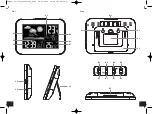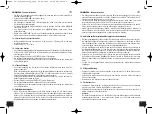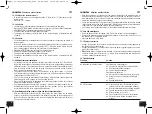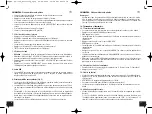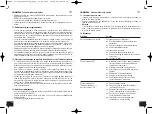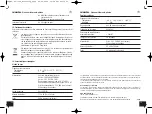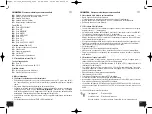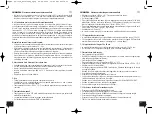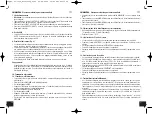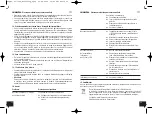
19
18
PRIMAVERA
- Wireless weather station
PRIMAVERA
- Wireless weather station
A6:
Symbol for indoors
A7:
Indoor temperature and humidity
Tasten (Fig. 2)
B1:
SNOOZE/LIGHT button
B2:
SET button
B3:
MAX/MIN button
B4:
ALARM button
B5:
HEAT/DEW button
B6:
+/RCC button
B7:
CH button
B8:
-/C/°F button
B9:
LIGHT HOLD ON/OFF button
Housing (Fig. 1+2)
C1:
Wall mount holes
C2:
Battery compartment
C3:
Stand (fold out)
C4:
USB output
C5:
Power adaptor connector
5.2 Outdoor transmitter (Fig. 3)
Buttons in the battery compartment
D1:
TX button
D2:
Switch 1-2-3 for channel selection
Housing
E1:
Wall mounting hole
E2:
Battery compartment (screwed)
6. Getting started
6.1 Connecting the base station to power adapter
• Place both instruments on a desk with a distance of approximately 1.5 meter. Avoid
getting close to possible interference sources (Electronic devices and radio installa-
tions).
• Remove the protective foil from the display of the base station.
• Connect the base station to the attached power adapter. Insert the adapter into the jack
at the base station and connect the power adapter to a wall socket.
Important!
Make
sure that your household voltage is not more than 240V! Otherwise your device may
be damaged.
• The device will alert you with a beep and all LCD segments will be displayed for a short
moment.
• TIME and 0:00 (default) appear on the display.
• The base station and the mains adapter must not come into contact with water or
moisture. It should be operated in dry interiors.
• Do not use the device if the housing or the mains adapters are damaged.
• Keep the device out of reach of persons (including children) who cannot fully appreci-
ate the potential risks of handling electrical equipment.
• Pull out the plug of the socket immediately if any fault occurs or if the device is not
used for a long period of time.
• Only use the supplied mains adapter.
• First connect the lead to the base station and then insert the mains adapter into the
socket.
• Do not pull the mains adapter out of the socket by its lead.
• Route the mains lead so that it does not come into contact with sharp-edged or hot
objects.
Caution!
Risk of injury:
• Keep these instruments and the batteries out of reach of children.
• Batteries contain harmful acids and may be hazardous if swallowed. If a battery is
swallowed, this can lead to serious internal burns and death within two hours. If you
suspect a battery could have been swallowed or otherwise caught in the body, seek
medical help immediately.
• Batteries must not be thrown into a fire, short-circuited, taken apart or recharged. Risk
of explosion!
• Low batteries should be changed as soon as possible to prevent damage caused by
leaking. Never use a combination of old and new batteries together, nor batteries of
different types.
• Wear chemical-resistant protective gloves and safety glasses when handling leaking
batteries.
Important information on product safety!
• Do not place your device near extreme temperatures, vibrations or shocks.
• Protect it from moisture.
• The outdoor transmitter is protected against splash water, but is not watertight.
Choose a shady and dry position for the outdoor transmitter.
5. Elements and buttons
5.1 Base station (Receiver)
Display (Fig. 1)
A1:
Weather forecast with symbols
A2:
Outdoor temperature and humidity
A3:
Symbol for outdoor transmitter with channel number
A4:
Time, weekday and date
A5:
Alarm symbol
TFA_No. 35.1136_Anleitung_04_20 09.04.2020 14:08 Uhr Seite 10


